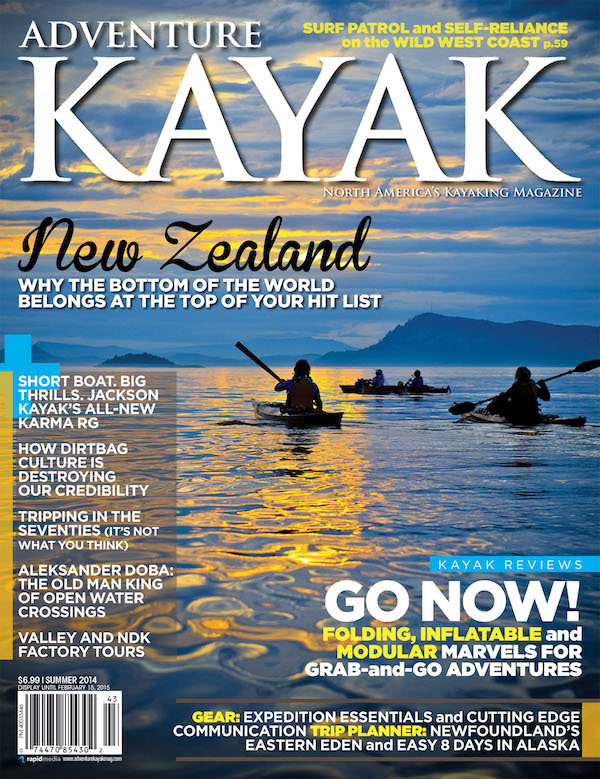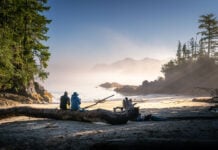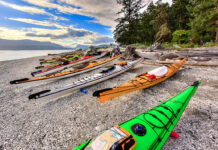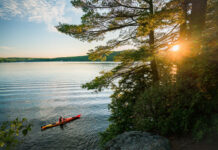This photograph, taken by Werner Furrer Sr., the patriarch of the Werner Paddles family, reflects the coastal camping scene back in the early 1970s.
At left is Werner’s son Erich, wearing denim cut-offs and providing a bit of privacy as his brother Bruce slips into something more comfortable…well, at least into something. Werner’s wife, Marta, presides over the cooking area while Rita, a family friend, tends to the campfire griddle. Tom Derrer, founder of Eddyline Kayaks, whose first sea kayak Werner will design in 1975, chills behind his stellar shades and mustache while Werner Jr. mellows out in a tie-dye sweatshirt, waiting for breakfast.
The two decked, open-ocean canoes in the background were hand built by Werner and Derrer, the direct predecessors of that first Eddyline sea kayak. The boats are lashed together catamaran-style—all the better to carry a few sturdy cardboard boxes full of food—and propelled by canoe paddles and a small outboard motor.
A lot has changed in the four decades
A lot has changed in the four decades since this picture was taken. Young men generally don’t wear their socks quite so high or their shorts so short. Cotton clothes have given way to technical fabrics designed for moisture management in the wilderness. Heavy rectangular tarps have been replaced with ultralight nylon, catenary-cut shelters. Even more game-changing than silicone-treated tents and tarps are the effects of Silicon Valley. Satellite messaging, GPS pinpointing and smartphone connectivity have become commonplace on wilderness trips.
My father introduced me to wilderness camping in the 1960s when I was in my tween years. I wore the same clothes that I wore at home with the addition of a scratchy wool shirt, sweater and socks for cold weather. The only shelter we had was a square of black Visqueen plastic sheeting without grommets or even a hemmed edge. We pulled it taut with cords tied around walnut-sized rocks captured in the corners of the plastic. Communication options were limited to smoke signals and semaphores.
By today’s standards we were woefully equipped. There were times when I was miserable, but they served to heighten the moments of elation: gazing up at a bright Milky Way streaked by falling stars, crouching on all fours to kiss a mountain stream and drink its sweet cold water, standing amid the dappled light of a forest carpeted with luminous green moss.

In the ‘60s and ‘70s, you didn’t need permits for camping
In the ‘60s and ‘70s, you didn’t need permits for camping—even the most popular areas could scarcely be called crowded. The only other person the Furrer group saw on their tour of the Bunsby Islands off Vancou- ver Island’s west coast was a very old native woman who lived there. Leave-no-trace had not yet become an institution or catchphrase—“You didn’t even have to talk about it,” Werner Sr. tells me when I visit his home in Everett, Washington, to reminisce about this photo. Leaving wild places as one found them was automatic, a gesture of respect and affection for the land.
While there have been some significant changes to the wilderness experience, it still provides us with an opportunity to answer a question Werner posed to himself on his very first expedition, a two-week paddle on a remote river in Northern Ontario: “How do I get along with myself?”
Later, as a father, the isolated coasts he paddled with his family gave him the chance to teach his children valuable lessons about discipline and self-sufficiency.
We may now bring different resources into the wilderness, but we can only hope that what it brings to us will always be the same.
Reflections columnist Christopher Cunningham is the former editor of Sea Kayaker magazine.
This article first appeared in the Summer 2014 issue of Adventure Kayak Magazine. Subscribe to Paddling Magazine and get 25 years of digital magazine archives including our legacy titles: Rapid, Adventure Kayak and Canoeroots.









